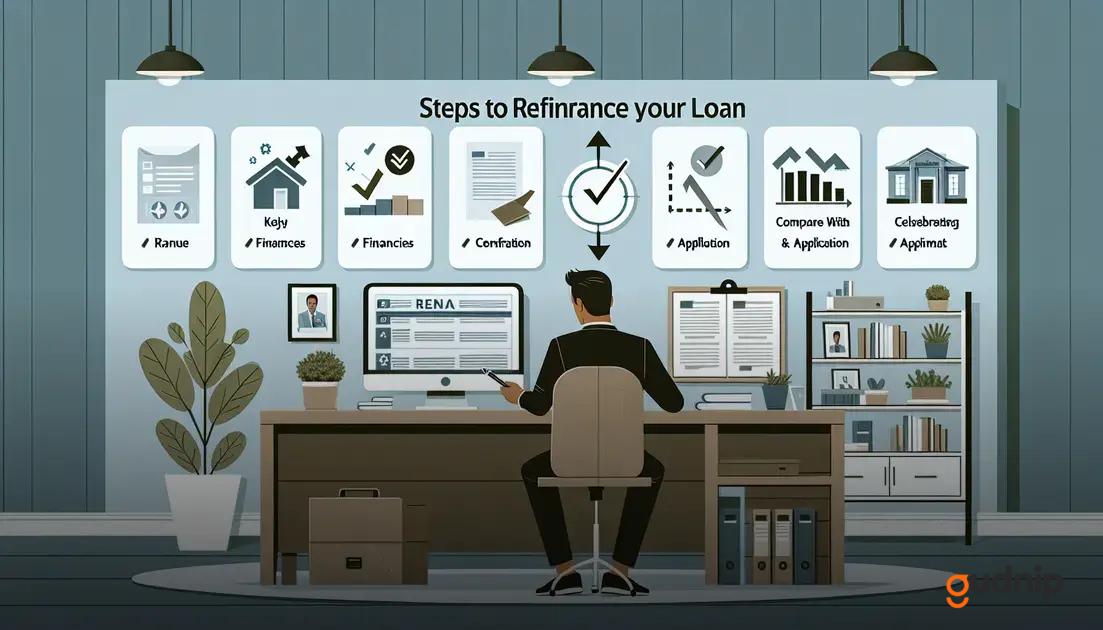Loan refinancing offers an excellent opportunity to reduce your monthly payments and save money in the long-term. By understanding the benefits, eligibility criteria, and the process, you can make an informed decision.
What is loan refinancing?
Loan refinancing refers to the process of taking out a new loan to pay off one or more existing loans. This can be done for various reasons, but most commonly, it is performed to secure better loan terms, such as a lower interest rate, reduced monthly payments, or better loan conditions. Essentially, refinancing replaces your current loan with a new one that typically offers more favorable terms.
How Does Loan Refinancing Work?
When you refinance a loan, you apply for a new loan through either your current lender or a new one. The new loan is then used to pay off the outstanding balance of your existing loan. After the refinance is completed, you start making payments on the new loan under the new terms agreed upon.
Several types of loans can be refinanced, including mortgages, auto loans, and student loans. Each type of loan refinancing comes with its own set of conditions and potential benefits. It’s crucial to understand these nuances to make the most out of refinancing.
Key Factors to Consider
Before refinancing, it’s important to consider several key factors. These include your credit score, the current interest rates, and any potential fees associated with refinancing. Also, evaluate your current financial situation to ensure refinancing aligns with your long-term financial goals.
An additional aspect to consider is the break-even point, which is the time it takes for the savings gained from a lower interest rate to surpass the costs incurred during the refinancing process. By accurately calculating this break-even point, you can better decide if refinancing is a viable option for you.
It’s also advisable to shop around and compare different lenders before deciding to ensure you get the best possible deal.
Benefits of loan refinancing

Lower Monthly Payments
By refinancing your loan, you can secure a lower interest rate, leading to reduced monthly payments. Lower payments mean you have more money in your budget for other expenses or savings.
Shorten Loan Term
Refinancing gives you the option to shorten the term of your loan. A shorter loan term means you pay off your debt faster, helping you become debt-free sooner.
Lower Interest Rates
One of the primary benefits of refinancing is obtaining a lower interest rate. A reduced rate decreases the amount of interest you pay over the life of the loan, saving you a substantial amount of money.
Switch Loan Type
You can refinance to switch from a variable-rate loan to a fixed-rate loan, thereby stabilizing your monthly payments and protecting you from interest rate increases.
Consolidate Debt
If you have multiple loans or credit card debts, refinancing can help you consolidate them into one single loan, simplifying your finances and potentially lowering the overall interest rate.
Improve Credit Score
Successfully refinancing your loan and making timely payments can positively impact your credit score. A better credit score can help you secure better loan terms and rates in the future.
How to qualify for loan refinancing
Check Your Credit Score
Your credit score is a crucial factor. Lenders will look at your score to determine your eligibility. A higher score can unlock better rates, so try to improve it before applying.
Ensure Steady Income
Lenders need to see a steady income that can cover your new loan payments. Gather your pay stubs, tax returns, or bank statements to show your financial stability. Consistent income makes you a lower risk borrower.
Debt-to-Income Ratio
This ratio compares your monthly debt payments to your gross monthly income. Lenders prefer a debt-to-income ratio below 36%. Pay down existing debt to improve your odds of qualifying.
Home Equity
If you’re refinancing a mortgage, your home equity plays a role. The more equity you have, the better your chances. Aim for at least 20%. If your equity is low, consider postponing refinancing until you’ve paid down more of your original mortgage.
Shop Around
Different lenders have different qualifications. Research multiple lenders to find the best fit for your financial situation. Compare rates, terms, and application requirements to get the best deal.
Documentation
Gather all necessary documents before applying. This includes proof of income, current loan statements, and credit reports. Organized paperwork speeds up the process and shows you are a prepared borrower.
Consult a Financial Advisor
Before making any decisions, it’s wise to talk to a financial advisor. They can provide tailored advice based on your unique financial situation and help you understand all implications of refinancing.
Steps to refinance your loan

The first step is to check your current loan terms. Understand the interest rate, monthly payments, and the remaining balance. Knowing these details will help you determine if refinancing is worth it.
Next, research potential lenders. Look for those offering lower interest rates or better terms. Use online comparison tools to get an overview of the best options available.
After selecting a lender, gather all the required financial documents. These often include pay stubs, tax returns, and a list of your current debts. Having everything prepared can speed up the process.
Submit your application and wait for approval. Lenders will review your credit score, income, and other financial details. A solid financial standing increases your chances of getting approved.
If approved, carefully read through the new loan terms. Ensure you understand all fees, penalties, and payment schedules. Don’t hesitate to ask the lender if anything is unclear.
Finally, finalize the loan and begin making payments according to the new terms. Keep track of your finances to make sure you’re saving money in the long run.
Common mistakes to avoid when refinancing
1. Not Shopping Around for the Best Rates
Many people make the mistake of accepting the first refinancing offer they receive. Compare multiple lenders to find the best rates and terms.
2. Ignoring Loan Fees and Closing Costs
While looking for better rates, don’t forget to factor in the loan fees and closing costs. These can significantly impact your savings.
3. Extending Your Loan Term
Extending your loan term might lower your monthly payments temporarily, but it can increase the overall interest paid. Consider the long-term costs.
4. Falling for Teaser Rates
Teaser rates are often low initially but can increase over time. Make sure you understand what your rate will be after the initial period.
5. Not Checking Your Credit Score
Your credit score plays a crucial role in the rates you qualify for. Check your credit score before applying and take steps to improve it if necessary.
6. Overlooking the Break-Even Point
Calculate when the savings from the new rate will cover the costs associated with refinancing to ensure it’s a good financial decision.
7. Taking Cash-Out Refinancing Without Understanding the Consequences
While cash-out refinancing can provide you with extra funds, it also increases your loan balance and can put your home at risk if you’re unable to make payments.
8. Failing to Lock in Your Interest Rate
Not locking in your rate can expose you to rising rates during the loan processing period. Ask your lender about rate lock options.





